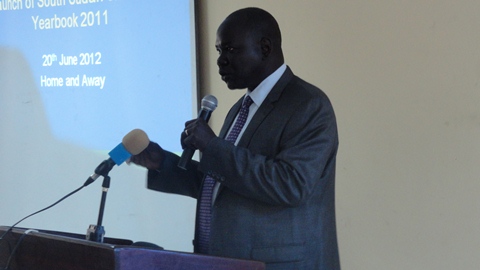Over 4 million S. Sudanese still live in poverty: survey
By Julius N. Uma
June 20, 2012 (JUBA) – At least four million South Sudanese, nearly half of the country’s population, still live below the poverty, implying that one out of every two individuals cannot obtain the minimum level of basic needs, a survey conducted by the National Bureau of Statics (NBS) indicates.

The National Baseline Household Survey (NBHS), which was conducted in 2009, to assess the standards of living of the population in South Sudan, also shows a huge gap in poverty levels between rural and urban areas.
“There is a much higher level of poverty in rural than urban areas. While more than half of the rural population lives below the poverty lined, one in four people does the same in urban areas,” the report reads in part.
According to the survey, for instance, average food consumption in urban areas is SSP 109 (about $35) per person monthly, which is reportedly 50 percent more than food consumption in rural areas, estimated at just SSP 73 ($20) per month.
The survey, carried out between April and May 2009, cites the Greater Bahr el Ghazal region as the poorest region in South Sudan, with the highest poverty levels (62%), followed by the Greater Equatoria (45%) and the Greater Upper Nile (44%).
Also of concern, according to the 140-page report, is the high poverty level among female headed households when compared to the ones headed by their male counterparts, while the poverty levels reportedly reduce with increase in education levels of household heads.
“Poverty also goes down when the education level of the household goes up,” it says, adding that, “55 percent of population head without schooling live under the poverty line, only 11 percent of those who’s headed the household has post-secondary education level.”
The goal to eradicate extreme poverty and hunger remains top of the United Nations Millennium Goals (MDGs), expected to be met by 2015. However, although the international indicator for poverty is the proportion of population living on less than a dollar ($1) per day, South Sudan’s data is not yet estimated since it attained independence less than a year ago.
Speaking at the launch of South Sudan’s Statistical Year book on Wednesday, the country’s Vice President, Riek Machar said statistical findings help government know the socio-economic conditions of the population, hence formulate appropriate policies.
“Without information, we cannot target appropriate relevant policies. Without relevant information, we cannot choose priorities,” said Machar, in a statement read by Kwong Danhier Gatluak, South Sudan’s deputy minister for Labor, Public Service and Human Resource Development.
“In the same way, without information, we cannot effectively measure progress and there can be no form of accountability to the population,” he added.
Although he acknowledged the numerous challenges facing South Sudan, citing poverty, under development and economic fragility, the Vice-President reiterated the country’s commitment towards overcoming these obstacles in the long-run.
George Conway, the acting United Nations Development Programme (UNDP) lauded the South Sudan’s statistical bureau for the “excellent” work done, and pledged the organizations firm commitment and continued partnership with the government body.
Hanne Marrie Kaarstad, the deputy Norwegian ambassador to South Sudan said reliable data provided by NBS will not only help government adopt policies for future use, but also help in assessing its work, hence a benchmark for decision making.
“The National Bureau of Statistics should now strive to ensure that the publication is widely disseminated to the various stakeholders, government, development partners and the citizens, so that they are enlightened about these issues,” Kaarstad said.
Meanwhile, NBS is set to develop a five-year (2012-2017) national strategy for development of statistics, to be used by the government-owned institution as a guiding principle for data collection, tabulation and formulation.
(ST)
